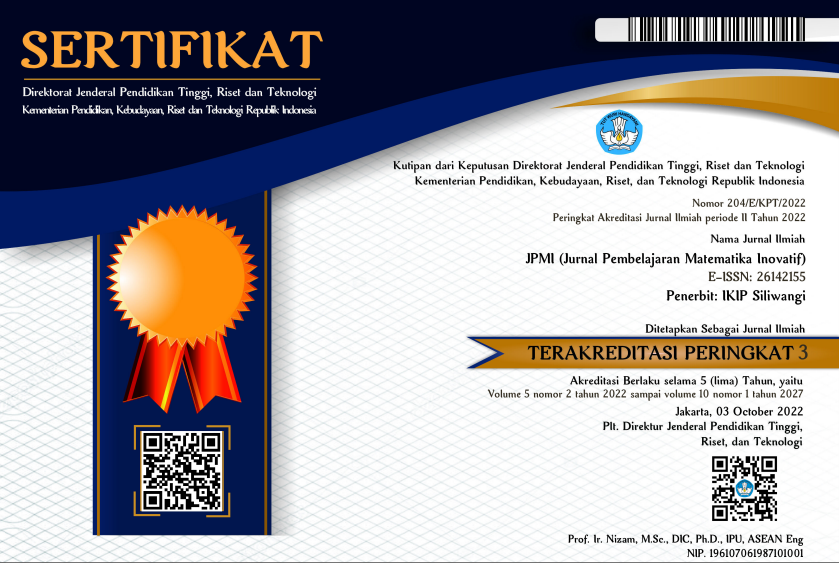PENGARUH PENDEKATAN SAINTIFIK TERHADAP KEMAMPUAN KOMUNIKASI MATEMATIS SISWA KELAS VIII SMP IT BUDI LUHUR CIMAHI PADA MATERI PERSAMAAN GARIS LURUS
DOI:
https://doi.org/10.22460/jpmi.v6i1.10922Keywords:
scientific approach, mathematical communication, straight line equationAbstract
The purpose of this study is to analyze and find out the mathematical communication skills of junior high school students by using a scientific approach to the material of straight-line equations. This research consists of two cycles based on the Kemmis & Taggart model. which consists of: planning, implementation, observation, and reflection. The subject of this study was 30 students of VIII grade from SMP IT Budi Luhur Cimahi of 2021/2022 academic year. The test instrument used in accordance with the indicators of mathematical communication ability is in the form of a description of as many as 5 numbers. Normalized gain data was generated in this study, resulting in a score of 0.36. Data processing in the study was obtained from normalized gain data, with a score of 0.36. This shows that students' mathematical communication skills have improved, with a moderate category. The non-test instruments used included a questionnaire on the scale of learning interest attitudes as many as 16 balanced statements with positive and negative responses. The results of the response to students' interest in learning mathematics have a positive effect on students' mathematical communication, namely 76.6 with a positive category.
References
Aini, I. N., & Firdaus, M. F. (2020). Analisis Kemampuan Komunikasi Matematis Siswa SMP Pada Materi Segitiga dan Segiempat. Prosiding Seminar Nasional Matematika dan Pendidikan Matematika Sesiomadika 2019, 529-537. https://www.researchgate.net/publication/344373937
Arsiyanto, A. R., & Wanabuliandari, S., & Fajrie, N. (2021). Faktor-Faktor Hasil Pemahaman Konsep Metamatis Dalam Pembelajaran Masa Pandemi Covid-19. Jurnal Ilmiah P2M STKIP Siliwangi, 8(1), 1–14. https://doi.org/10.22460/p2m.v8i1p1-14.2226
Asmaranti, W., & dkk. (2018). Desain Lembar Kerja Peserta Didik (LKPD) Matematika dengan Pendekatan Saintifik Berbasis Pendidikan Karakter. Prosiding Seminar Nasional Etnomatnesia, 639–646.
Halimah, S. N., & Rahmi, D. (2020). Kemampuan Komunikasi Matematis pada Materi Segi Empat dan Segitiga : Analisis Deskriptif Berdasarkan Keaktifan Belajar di MTs Bustanul Ulum. 3(4), 357–366. http://dx.doi.org/10.24014/juring.v3i4.10490
Hayati, L., & Mulyani, M. (2019). Penerapan Pendekatan Saintifik untuk Meningkatkan Kemampuan Komunikasi Matematis Siswa Sekolah Menengah Pertama. Jurnal Pijar Mipa, 14(1), 44-49. 10.29303/jpm.v14i1.998
Hendriana, H., & Afrilianto, M. (2017). Langkah Praktis Penelitian Tindakan Kelas Bagi Guru. Bandung: Refika Aditama.
Ismayanti, S., & Sofyan, D. (2021). Kemampuan Komunikasi Matematis Siswa SMP Kelas VIII di Kampung Cigulawing. 1(1), 183–196. https://doi.org/10.31980/plusminus.v1i1.1036
Kahar, M., Layn, M., & Mandasari, I. (2018). Pengaruh Penerapan Model Pembelajaran Interactive Conceptual Interaction (ICI) Dalam Pemecahan Masalah Matematika Peserta Didik. Jurnal Noken: Ilmu-Ilmu Sosial, 3(2), 56–62. https://doi.org/10.33506/jn.v3i2.108
Manalu, A. C. S., & Afrilianto, M. (2020). Peningkatan Kemampuan Pemahaman Matematis Siswa Kelas VIII SMP Pasundan 9 Bandung pada Materi Persamaan Garis Lurus dengan menggunakan Pendekatan Konstektual. JPMI (Jurnal Pembelajaran Matematika Inovatif), 3(4), 363–370. https://doi.org/10.22460/jpmi.v3i4.363-370
Mardianto, Y., Azis, L. A., & Amelia, R. (2022). Menganalisis Respon Siswa Terhadap Pembelajaran Materi Perbandingan Dan Skala Menggunakan Pendekatan Kontekstual. JPMI (Jurnal Pembelajaran Matematika Inovatif), 5(5), 1313–1322. https://doi.org/10.22460/jpmi.v5i5.1313-1322
Noviana, F., Mulqiyono, S., & Afrilianto, M. (2018). Kemampuan Komunikasi Matematik Siswa Smp Kelas IX Pada Materi Bangun Ruang Sisi Datar Di Kabupaten Bandung. JPMI (Jurnal Pembelajaran Matematika Inovatif), 1(4), 583–590. http://dx.doi.org/10.22460/jpmi.v1i4.p583-590
Nugrawati, U., Nuryakin, & Afrilianto, M. (2018). Analisis Kesulitan Belajar Pada Kemampuan Komunikasi Matematis Siswa MTs Dengan Materi Segitiga Dan Segiempat. Indomath: Indonesian Mathematics Education 1(2), 63–68. https://doi.org/10.30738/indomath.v1i2.2543
Purwaningsih, S. W., & Marlina, R. (2022). Analisis Kemampuan Pemahaman Konsep Matematis Siswa Smp Kelas VII Pada Materi Bentuk Aljabar. 5(3), 639–648. https://doi.org/10.22460/jpmi.v5i3.639-648
Purwasih, R., Sari, N. R., & Agustina, S. (2018). Analisis Kemampuan Literasi Matematika Dan Mathematical Habits Of Mind Siswa SMP Pada Materi Bangun Ruang Sisi Datar. Numeracy, 5(1), 67–76. https://doi.org/10.46244/numeracy.v5i1.318
Sarminah. (2018). Penerapan Pendekatan Kontekstual Untuk Meningkatkan Hasil Belajar Ipa Kelas VI SD Negeri 004 Tembilahan Kota Kecamatan Tembilahan. Jurnal PAJAR (Pendidikan dan Pengajaran) , 2(2), 293–299. http://dx.doi.org/10.33578/pjr.v2i2.5079
Setyorini, I., & Saefudin, A. A. (2020). Pengembangan LKS ( Lembar Kerja Siswa ) Materi Pola Bilangan dengan Pendekatan Scientific untuk Memfasilitasi Kemampuan Pemahaman Konsep Matematis Siswa. Aksioma, 11(1), 131–140. https://doi.org/10.26877/aks.v11i1.5609
Sugandi, A. I., & Bernard, M. (2018). Penerapan Pendekatan Kontekstual Terhadap Kemampuan Pemahaman Dan Komunikasi Siswa SMP. 4(1), 16–23. https://doi.org/10.15575/ja.v4i1.2364
Sunarto, M. T., Putri, S., Oria, Y., Ar-rahiiqil, Z., Siagian, G. T., & Afrilianto, M. (2021). Meningkatkan Kemampuan Pemahaman Matematis Siswa SMP melalui Pendekatan Kontekstual. 10, 85–94. https://doi.org/10.31980/mosharafa.v10i1.730
Widiani, T., Rif’at, M., & Ijuddin, R. (2016). Penerapan Pendekatan Saintifik Dan Pengaruhnya Terhadap Kemampuan Komunikasi Matematis Dan Berpikir Kreatif Siswa. Jurnal Pendidikan Dan Pembelajaran Khatulistiwa, 5(1), 1–14. http://dx.doi.org/10.26418/jppk.v5i1.13550
Downloads
Published
Issue
Section
License
Copyright (c) 2023 JPMI (Jurnal Pembelajaran Matematika Inovatif)

This work is licensed under a Creative Commons Attribution-ShareAlike 4.0 International License.
The author is responsible for acquiring the permission(s) to reproduce any copyrighted figures, tables, data, or text that are being used in the submitted paper. Authors should note that text quotations of more than 250 words from a published or copyrighted work will require grant of permission from the original publisher to reprint. The written permission letter(s) must be submitted together with the manuscript.
















